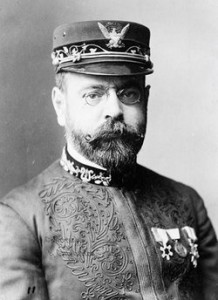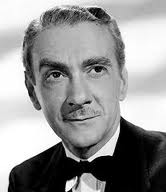What do “Stars and Stripes Forever,” Mr. Peabody, and ghosts have in common? Clifton Webb, of course! You’ll be glad to know I have found some very fun minutiae regarding yesterday’s Trivia Question of the Day:
QUESTION: (TV & Film): Who did actor Clifton Webb portray in the film “Stars and Stripes Forever?”
ANSWER: John Philip Sousa
What would a Fourth of July parade be without a rousing rendition of “The Stars and Stripes Forever?” Well, simply un-American! This famous march was written by John Philip Sousa, the beloved American composer and conductor best known for his military and patriotic marches.
Sousa’s career seems to have been written in the stars. He was born on November 6, 1854 near the Marine Barracks in Washington, D.C., where his father played trombone in the US Marine Band. He spent his early childhood listening to military band music and by the time he was six he was studying voice, violin, piano, flute, cornet, baritone, trombone, and alto horn. Sheesh, when I was six all I could play was Barbies!
Sousa tried to run away and join a circus band when he was 13, but his father redirected his passions toward the Marine Band as an apprentice. He remained with the band until he was 20. It was during these years that he wrote his first composition, “Moonlight on the Potomac Waltzes.”

After the Marines, he toured with theater orchestras. He later returned to Washington D.C., and assumed leadership of the US Marine Band. Over the next two years, Sousa conducted the band “The President’s Own,” serving under Presidents Hayes, Garfield, Cleveland, Arthur, and Harrison.
In 1896, Sousa and his wife were vacationing in Europe when they learned Sousa’s promoter, had died. On their return voyage, Sousa found the inspiration to begin writing his most famous song, “The Stars and Stripes Forever.”
Later that year, the 77-year-old musician passed away after conducting a rehearsal of the Ringgold Band in Reading, PA. The last piece Sousa rehearsed with the band was “The Stars and Stripes Forever.” Click on the link below to hear a wonderful performance of his march:
In addition to penning hundreds of marches, Sousa wrote ten operas and a number of musical suites. He also wrote three novels and an autobiography.
In 1976, Sousa was enshrined in the Hall of Fame for Great Americans in a ceremony at the John F. Kennedy Center for the Performing Arts in Washington. Only 102 people have received this honor. In 1987, “The Stars and Stripes Forever” was designated as the national march of the United States.
On December 22, 1952, Twentieth Century Fox released a film biography of Sousa. It covered his early days in the Marine Corps Band through the Spanish-American War in 1898. The film starred Clifton Webb, Debra Paget, and Robert Wagner, and was nominated for three Golden Globes.

Interestingly, Clifton Webb, who had starred in musicals on Broadway, had been offered the chance to play a supporting role in the MGM musical “The Band Wagon,” which is not considered a classic, but he passed it up to be in “Stars and Stripes Forever” because he wanted the leading role.
Clifton Webb was trained early in dance and theater. He quit school at age 13 to study music and painting, and by his mid-twenties he was performing on Broadway, in London, and on the silent screen.
Webb was known as fastidious, fussy, abrasive, and condescending. He never married or had children, and was inseparable from his overbearing mother Maybelle, with whom he lived until her death at 91. Webb never fully recovered from his mother’s death; after making just one more film, he spent the remainder of his life in seclusion until his death of an apparent heart attack in 1966.
Here are some interesting tidbits about Clifton Webb according to Encyclopedia Brittanica:

- He was the inspiration for the cartoon character Mr. Peabody on Rocky and his Friends and Bullwinkle (1959-1964).
- Webb and his mother moved into a high-end home on Rexford Drive in Beverly Hills in 1947 that was known for two things: lavish parties and ghosts. Webb confided to friends that he had seen the ghost of a previous tenant, Metropolitan Opera Star, Grace Moore. She had been killed in a plane crash in 1947.
- When Maybelle passed away in 1959, Webb saw her presence in the house.
- Several days before he died in October 1966, Webb said, “I’m not leaving this house – even at death.” In 1967, gossip columnist Joyce Haber and film producer Douglas Cramer purchased the home. Several times the couple saw a swaying figure in the master bedroom that resembled Webb. Douglas also saw shadows in the hallway the size and shape of Maybelle. His dogs barked at and sometimes urinated on cold spots in the hallway – an area where insomniac Webb was known to pace in the middle of the night. When the dogs later saw Webb’s image on a TV screen all three began howling.
- Webb and Maybelle now share a mausoleum at Hollywood Forever Cemetery. His spirit has been seen pacing the long marble corridor of their eternal resting place.
Stay tuned for today’s question, which will be at around noon (central time) on my facebook author page:
www.facebook.com/pages/Amy-Hammond-Hagberg/107548285944928?ref=hl